Finance for Strategic Managers: Financial Analysis and Reporting
VerifiedAdded on 2019/12/04
|16
|4137
|207
Report
AI Summary
This comprehensive report delves into the critical role of finance in strategic management. It begins with an introduction to the necessity of financial information in business, exploring how managers utilize data from company accounts to make informed decisions, analyze performance, and manage risks. The report then examines financial statement analysis, including the purpose, structure, and interpretation of published accounts, along with the calculation and application of financial ratios to support strategic business decisions. It distinguishes between short-term and long-term financial requirements, comparing various sources of finance and exploring cash flow management techniques. Furthermore, the report touches upon business ownership structures, corporate governance, and the evaluation of strategic capital or investment projects. The report utilizes examples from Sainsbury's financial statements to illustrate key concepts and provides practical insights into effective financial management for achieving long-term business success.

FINANCE FOR STRATEGIC
MANAGERS
1 | P a g e
MANAGERS
1 | P a g e
Paraphrase This Document
Need a fresh take? Get an instant paraphrase of this document with our AI Paraphraser
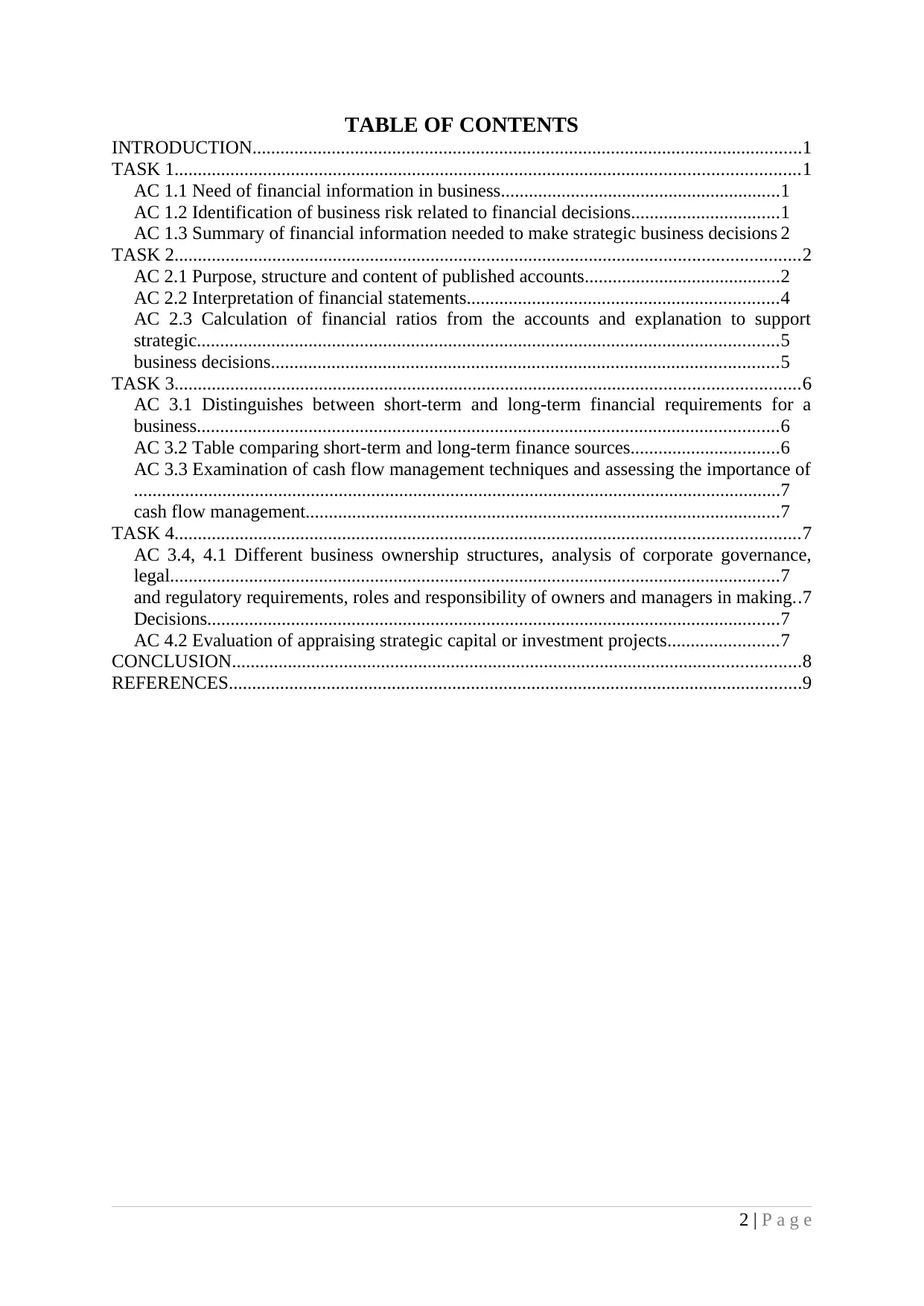
TABLE OF CONTENTS
INTRODUCTION......................................................................................................................1
TASK 1......................................................................................................................................1
AC 1.1 Need of financial information in business............................................................1
AC 1.2 Identification of business risk related to financial decisions................................1
AC 1.3 Summary of financial information needed to make strategic business decisions 2
TASK 2......................................................................................................................................2
AC 2.1 Purpose, structure and content of published accounts..........................................2
AC 2.2 Interpretation of financial statements...................................................................4
AC 2.3 Calculation of financial ratios from the accounts and explanation to support
strategic.............................................................................................................................5
business decisions.............................................................................................................5
TASK 3......................................................................................................................................6
AC 3.1 Distinguishes between short-term and long-term financial requirements for a
business.............................................................................................................................6
AC 3.2 Table comparing short-term and long-term finance sources................................6
AC 3.3 Examination of cash flow management techniques and assessing the importance of
...........................................................................................................................................7
cash flow management......................................................................................................7
TASK 4......................................................................................................................................7
AC 3.4, 4.1 Different business ownership structures, analysis of corporate governance,
legal...................................................................................................................................7
and regulatory requirements, roles and responsibility of owners and managers in making..7
Decisions...........................................................................................................................7
AC 4.2 Evaluation of appraising strategic capital or investment projects........................7
CONCLUSION..........................................................................................................................8
REFERENCES...........................................................................................................................9
2 | P a g e
INTRODUCTION......................................................................................................................1
TASK 1......................................................................................................................................1
AC 1.1 Need of financial information in business............................................................1
AC 1.2 Identification of business risk related to financial decisions................................1
AC 1.3 Summary of financial information needed to make strategic business decisions 2
TASK 2......................................................................................................................................2
AC 2.1 Purpose, structure and content of published accounts..........................................2
AC 2.2 Interpretation of financial statements...................................................................4
AC 2.3 Calculation of financial ratios from the accounts and explanation to support
strategic.............................................................................................................................5
business decisions.............................................................................................................5
TASK 3......................................................................................................................................6
AC 3.1 Distinguishes between short-term and long-term financial requirements for a
business.............................................................................................................................6
AC 3.2 Table comparing short-term and long-term finance sources................................6
AC 3.3 Examination of cash flow management techniques and assessing the importance of
...........................................................................................................................................7
cash flow management......................................................................................................7
TASK 4......................................................................................................................................7
AC 3.4, 4.1 Different business ownership structures, analysis of corporate governance,
legal...................................................................................................................................7
and regulatory requirements, roles and responsibility of owners and managers in making..7
Decisions...........................................................................................................................7
AC 4.2 Evaluation of appraising strategic capital or investment projects........................7
CONCLUSION..........................................................................................................................8
REFERENCES...........................................................................................................................9
2 | P a g e

INDEX OF TABLES
Table 1: Computation of Pay-back period and accounting rate of return..................................9
Table 2: Calculation of Net present value and internal rate of return........................................9
3 | P a g e
Table 1: Computation of Pay-back period and accounting rate of return..................................9
Table 2: Calculation of Net present value and internal rate of return........................................9
3 | P a g e
⊘ This is a preview!⊘
Do you want full access?
Subscribe today to unlock all pages.

Trusted by 1+ million students worldwide
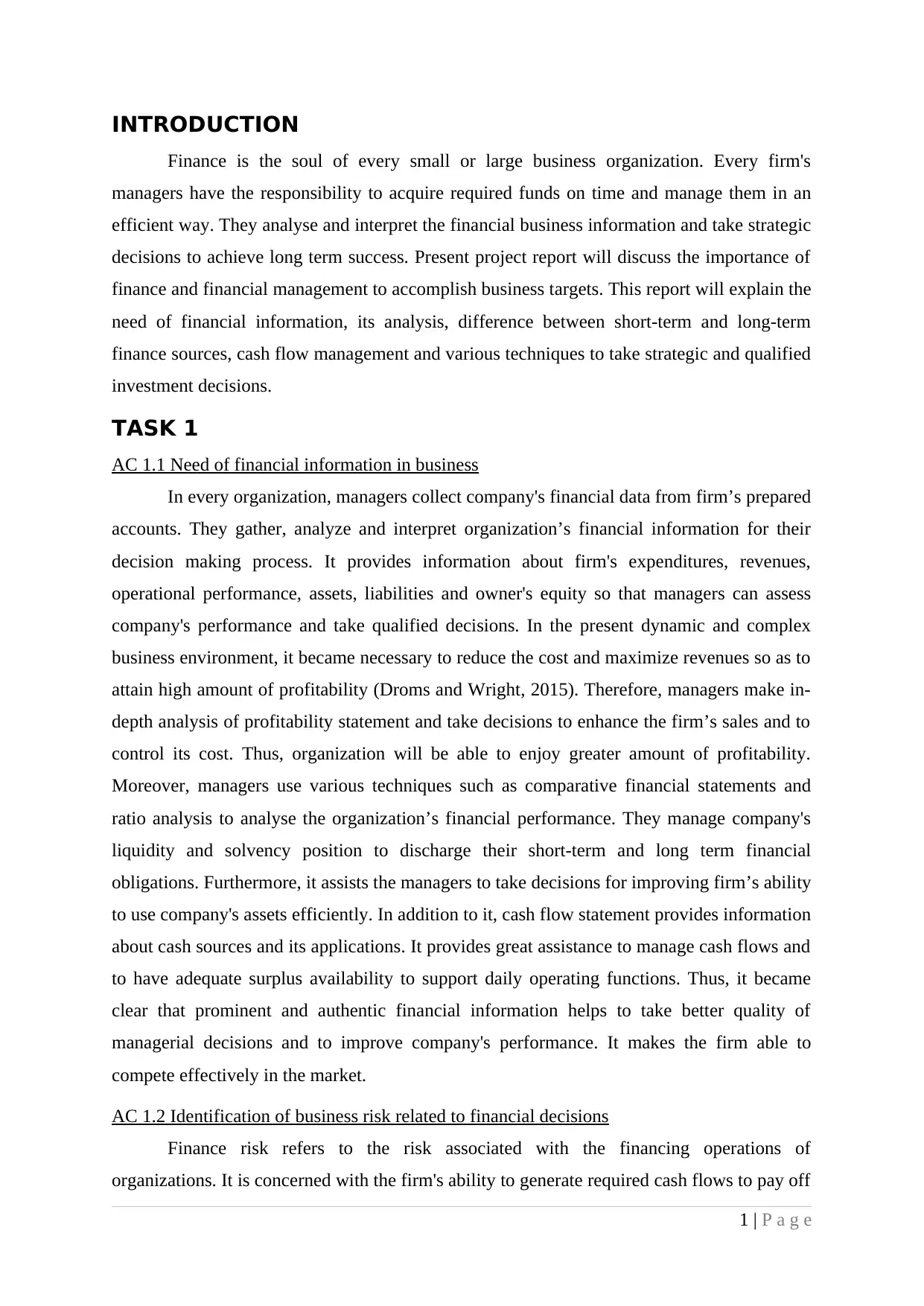
INTRODUCTION
Finance is the soul of every small or large business organization. Every firm's
managers have the responsibility to acquire required funds on time and manage them in an
efficient way. They analyse and interpret the financial business information and take strategic
decisions to achieve long term success. Present project report will discuss the importance of
finance and financial management to accomplish business targets. This report will explain the
need of financial information, its analysis, difference between short-term and long-term
finance sources, cash flow management and various techniques to take strategic and qualified
investment decisions.
TASK 1
AC 1.1 Need of financial information in business
In every organization, managers collect company's financial data from firm’s prepared
accounts. They gather, analyze and interpret organization’s financial information for their
decision making process. It provides information about firm's expenditures, revenues,
operational performance, assets, liabilities and owner's equity so that managers can assess
company's performance and take qualified decisions. In the present dynamic and complex
business environment, it became necessary to reduce the cost and maximize revenues so as to
attain high amount of profitability (Droms and Wright, 2015). Therefore, managers make in-
depth analysis of profitability statement and take decisions to enhance the firm’s sales and to
control its cost. Thus, organization will be able to enjoy greater amount of profitability.
Moreover, managers use various techniques such as comparative financial statements and
ratio analysis to analyse the organization’s financial performance. They manage company's
liquidity and solvency position to discharge their short-term and long term financial
obligations. Furthermore, it assists the managers to take decisions for improving firm’s ability
to use company's assets efficiently. In addition to it, cash flow statement provides information
about cash sources and its applications. It provides great assistance to manage cash flows and
to have adequate surplus availability to support daily operating functions. Thus, it became
clear that prominent and authentic financial information helps to take better quality of
managerial decisions and to improve company's performance. It makes the firm able to
compete effectively in the market.
AC 1.2 Identification of business risk related to financial decisions
Finance risk refers to the risk associated with the financing operations of
organizations. It is concerned with the firm's ability to generate required cash flows to pay off
1 | P a g e
Finance is the soul of every small or large business organization. Every firm's
managers have the responsibility to acquire required funds on time and manage them in an
efficient way. They analyse and interpret the financial business information and take strategic
decisions to achieve long term success. Present project report will discuss the importance of
finance and financial management to accomplish business targets. This report will explain the
need of financial information, its analysis, difference between short-term and long-term
finance sources, cash flow management and various techniques to take strategic and qualified
investment decisions.
TASK 1
AC 1.1 Need of financial information in business
In every organization, managers collect company's financial data from firm’s prepared
accounts. They gather, analyze and interpret organization’s financial information for their
decision making process. It provides information about firm's expenditures, revenues,
operational performance, assets, liabilities and owner's equity so that managers can assess
company's performance and take qualified decisions. In the present dynamic and complex
business environment, it became necessary to reduce the cost and maximize revenues so as to
attain high amount of profitability (Droms and Wright, 2015). Therefore, managers make in-
depth analysis of profitability statement and take decisions to enhance the firm’s sales and to
control its cost. Thus, organization will be able to enjoy greater amount of profitability.
Moreover, managers use various techniques such as comparative financial statements and
ratio analysis to analyse the organization’s financial performance. They manage company's
liquidity and solvency position to discharge their short-term and long term financial
obligations. Furthermore, it assists the managers to take decisions for improving firm’s ability
to use company's assets efficiently. In addition to it, cash flow statement provides information
about cash sources and its applications. It provides great assistance to manage cash flows and
to have adequate surplus availability to support daily operating functions. Thus, it became
clear that prominent and authentic financial information helps to take better quality of
managerial decisions and to improve company's performance. It makes the firm able to
compete effectively in the market.
AC 1.2 Identification of business risk related to financial decisions
Finance risk refers to the risk associated with the financing operations of
organizations. It is concerned with the firm's ability to generate required cash flows to pay off
1 | P a g e
Paraphrase This Document
Need a fresh take? Get an instant paraphrase of this document with our AI Paraphraser
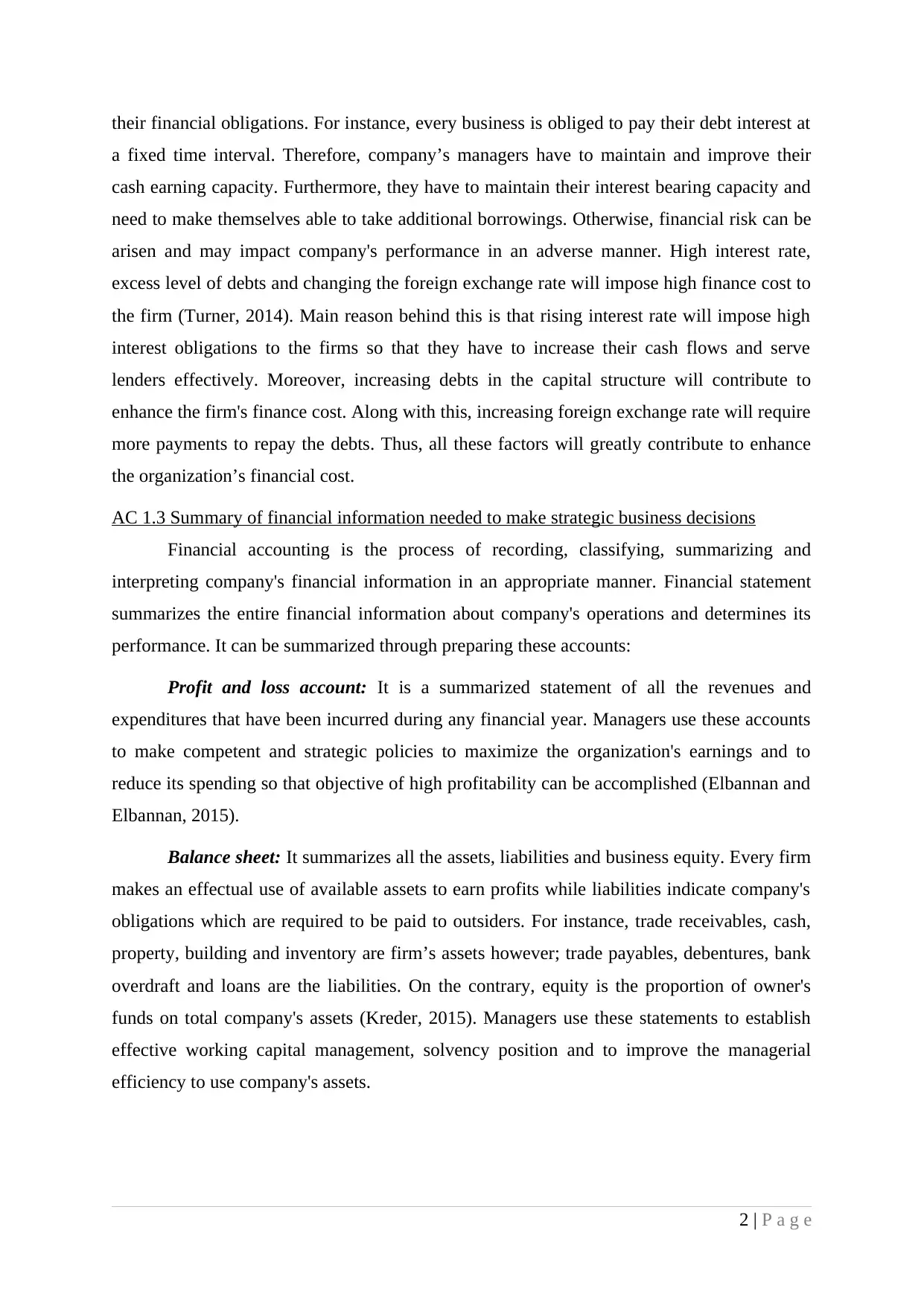
their financial obligations. For instance, every business is obliged to pay their debt interest at
a fixed time interval. Therefore, company’s managers have to maintain and improve their
cash earning capacity. Furthermore, they have to maintain their interest bearing capacity and
need to make themselves able to take additional borrowings. Otherwise, financial risk can be
arisen and may impact company's performance in an adverse manner. High interest rate,
excess level of debts and changing the foreign exchange rate will impose high finance cost to
the firm (Turner, 2014). Main reason behind this is that rising interest rate will impose high
interest obligations to the firms so that they have to increase their cash flows and serve
lenders effectively. Moreover, increasing debts in the capital structure will contribute to
enhance the firm's finance cost. Along with this, increasing foreign exchange rate will require
more payments to repay the debts. Thus, all these factors will greatly contribute to enhance
the organization’s financial cost.
AC 1.3 Summary of financial information needed to make strategic business decisions
Financial accounting is the process of recording, classifying, summarizing and
interpreting company's financial information in an appropriate manner. Financial statement
summarizes the entire financial information about company's operations and determines its
performance. It can be summarized through preparing these accounts:
Profit and loss account: It is a summarized statement of all the revenues and
expenditures that have been incurred during any financial year. Managers use these accounts
to make competent and strategic policies to maximize the organization's earnings and to
reduce its spending so that objective of high profitability can be accomplished (Elbannan and
Elbannan, 2015).
Balance sheet: It summarizes all the assets, liabilities and business equity. Every firm
makes an effectual use of available assets to earn profits while liabilities indicate company's
obligations which are required to be paid to outsiders. For instance, trade receivables, cash,
property, building and inventory are firm’s assets however; trade payables, debentures, bank
overdraft and loans are the liabilities. On the contrary, equity is the proportion of owner's
funds on total company's assets (Kreder, 2015). Managers use these statements to establish
effective working capital management, solvency position and to improve the managerial
efficiency to use company's assets.
2 | P a g e
a fixed time interval. Therefore, company’s managers have to maintain and improve their
cash earning capacity. Furthermore, they have to maintain their interest bearing capacity and
need to make themselves able to take additional borrowings. Otherwise, financial risk can be
arisen and may impact company's performance in an adverse manner. High interest rate,
excess level of debts and changing the foreign exchange rate will impose high finance cost to
the firm (Turner, 2014). Main reason behind this is that rising interest rate will impose high
interest obligations to the firms so that they have to increase their cash flows and serve
lenders effectively. Moreover, increasing debts in the capital structure will contribute to
enhance the firm's finance cost. Along with this, increasing foreign exchange rate will require
more payments to repay the debts. Thus, all these factors will greatly contribute to enhance
the organization’s financial cost.
AC 1.3 Summary of financial information needed to make strategic business decisions
Financial accounting is the process of recording, classifying, summarizing and
interpreting company's financial information in an appropriate manner. Financial statement
summarizes the entire financial information about company's operations and determines its
performance. It can be summarized through preparing these accounts:
Profit and loss account: It is a summarized statement of all the revenues and
expenditures that have been incurred during any financial year. Managers use these accounts
to make competent and strategic policies to maximize the organization's earnings and to
reduce its spending so that objective of high profitability can be accomplished (Elbannan and
Elbannan, 2015).
Balance sheet: It summarizes all the assets, liabilities and business equity. Every firm
makes an effectual use of available assets to earn profits while liabilities indicate company's
obligations which are required to be paid to outsiders. For instance, trade receivables, cash,
property, building and inventory are firm’s assets however; trade payables, debentures, bank
overdraft and loans are the liabilities. On the contrary, equity is the proportion of owner's
funds on total company's assets (Kreder, 2015). Managers use these statements to establish
effective working capital management, solvency position and to improve the managerial
efficiency to use company's assets.
2 | P a g e
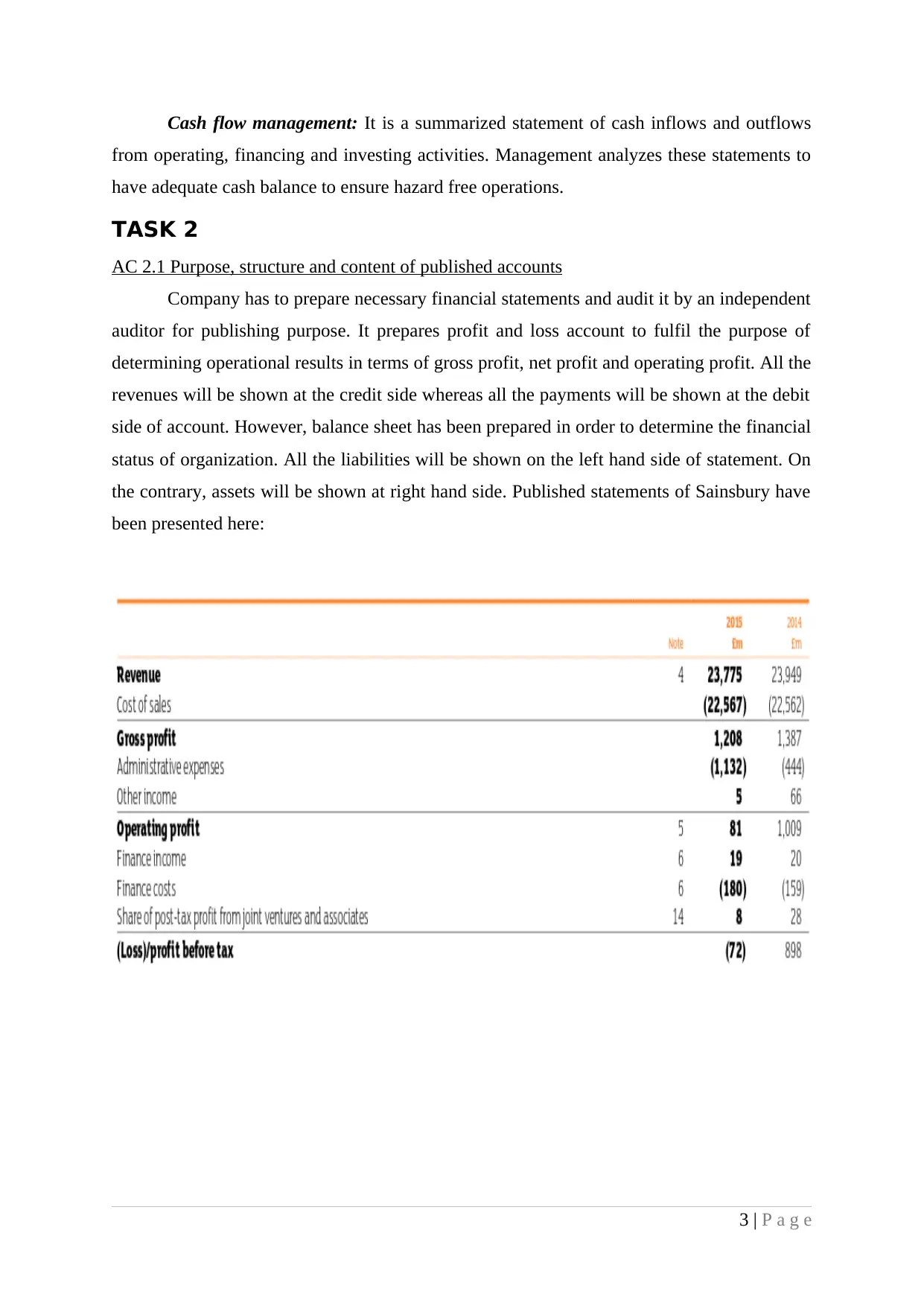
Cash flow management: It is a summarized statement of cash inflows and outflows
from operating, financing and investing activities. Management analyzes these statements to
have adequate cash balance to ensure hazard free operations.
TASK 2
AC 2.1 Purpose, structure and content of published accounts
Company has to prepare necessary financial statements and audit it by an independent
auditor for publishing purpose. It prepares profit and loss account to fulfil the purpose of
determining operational results in terms of gross profit, net profit and operating profit. All the
revenues will be shown at the credit side whereas all the payments will be shown at the debit
side of account. However, balance sheet has been prepared in order to determine the financial
status of organization. All the liabilities will be shown on the left hand side of statement. On
the contrary, assets will be shown at right hand side. Published statements of Sainsbury have
been presented here:
3 | P a g e
from operating, financing and investing activities. Management analyzes these statements to
have adequate cash balance to ensure hazard free operations.
TASK 2
AC 2.1 Purpose, structure and content of published accounts
Company has to prepare necessary financial statements and audit it by an independent
auditor for publishing purpose. It prepares profit and loss account to fulfil the purpose of
determining operational results in terms of gross profit, net profit and operating profit. All the
revenues will be shown at the credit side whereas all the payments will be shown at the debit
side of account. However, balance sheet has been prepared in order to determine the financial
status of organization. All the liabilities will be shown on the left hand side of statement. On
the contrary, assets will be shown at right hand side. Published statements of Sainsbury have
been presented here:
3 | P a g e
⊘ This is a preview!⊘
Do you want full access?
Subscribe today to unlock all pages.

Trusted by 1+ million students worldwide
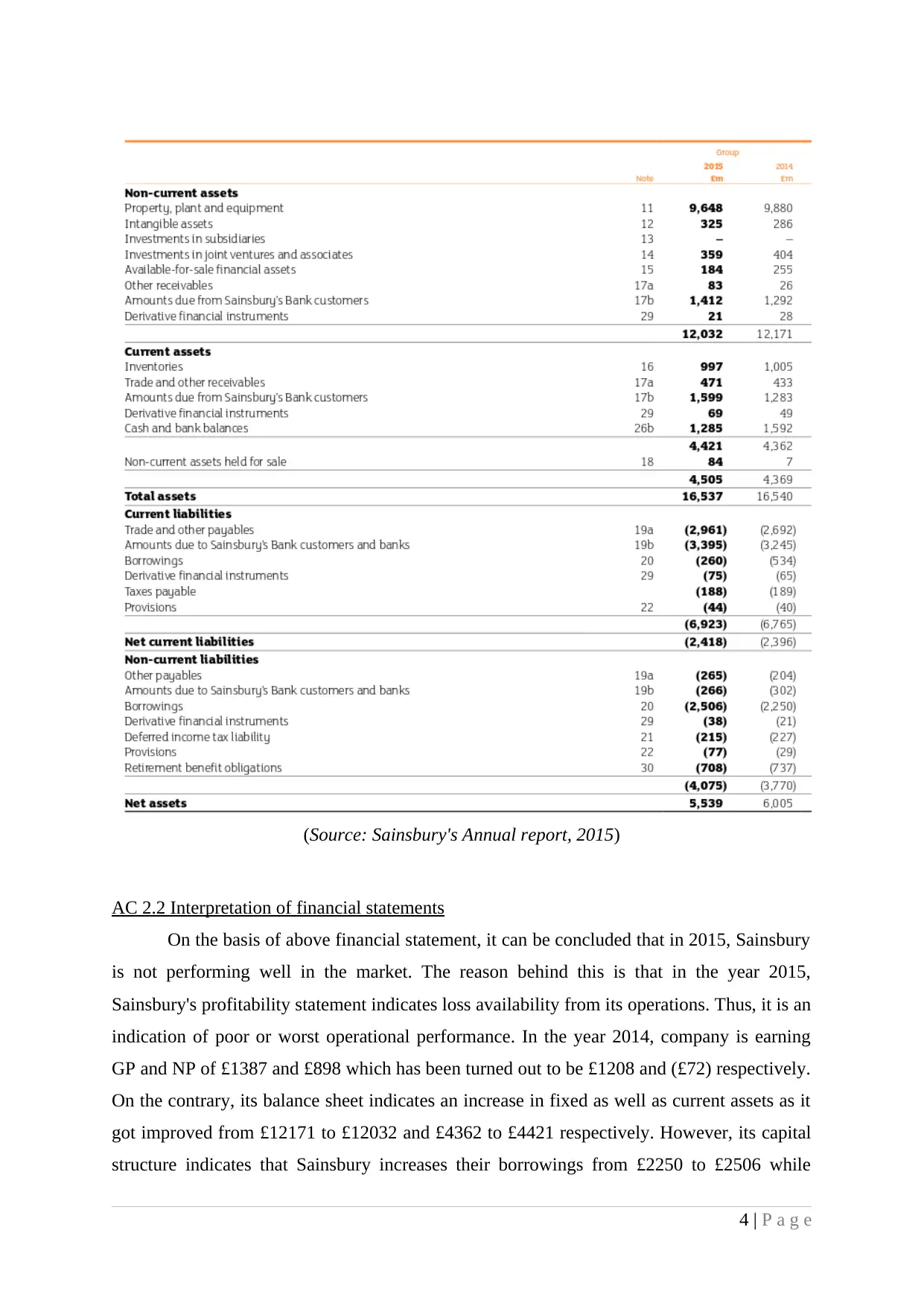
AC 2.2 Interpretation of financial statements
On the basis of above financial statement, it can be concluded that in 2015, Sainsbury
is not performing well in the market. The reason behind this is that in the year 2015,
Sainsbury's profitability statement indicates loss availability from its operations. Thus, it is an
indication of poor or worst operational performance. In the year 2014, company is earning
GP and NP of £1387 and £898 which has been turned out to be £1208 and (£72) respectively.
On the contrary, its balance sheet indicates an increase in fixed as well as current assets as it
got improved from £12171 to £12032 and £4362 to £4421 respectively. However, its capital
structure indicates that Sainsbury increases their borrowings from £2250 to £2506 while
4 | P a g e
(Source: Sainsbury's Annual report, 2015)
On the basis of above financial statement, it can be concluded that in 2015, Sainsbury
is not performing well in the market. The reason behind this is that in the year 2015,
Sainsbury's profitability statement indicates loss availability from its operations. Thus, it is an
indication of poor or worst operational performance. In the year 2014, company is earning
GP and NP of £1387 and £898 which has been turned out to be £1208 and (£72) respectively.
On the contrary, its balance sheet indicates an increase in fixed as well as current assets as it
got improved from £12171 to £12032 and £4362 to £4421 respectively. However, its capital
structure indicates that Sainsbury increases their borrowings from £2250 to £2506 while
4 | P a g e
(Source: Sainsbury's Annual report, 2015)
Paraphrase This Document
Need a fresh take? Get an instant paraphrase of this document with our AI Paraphraser
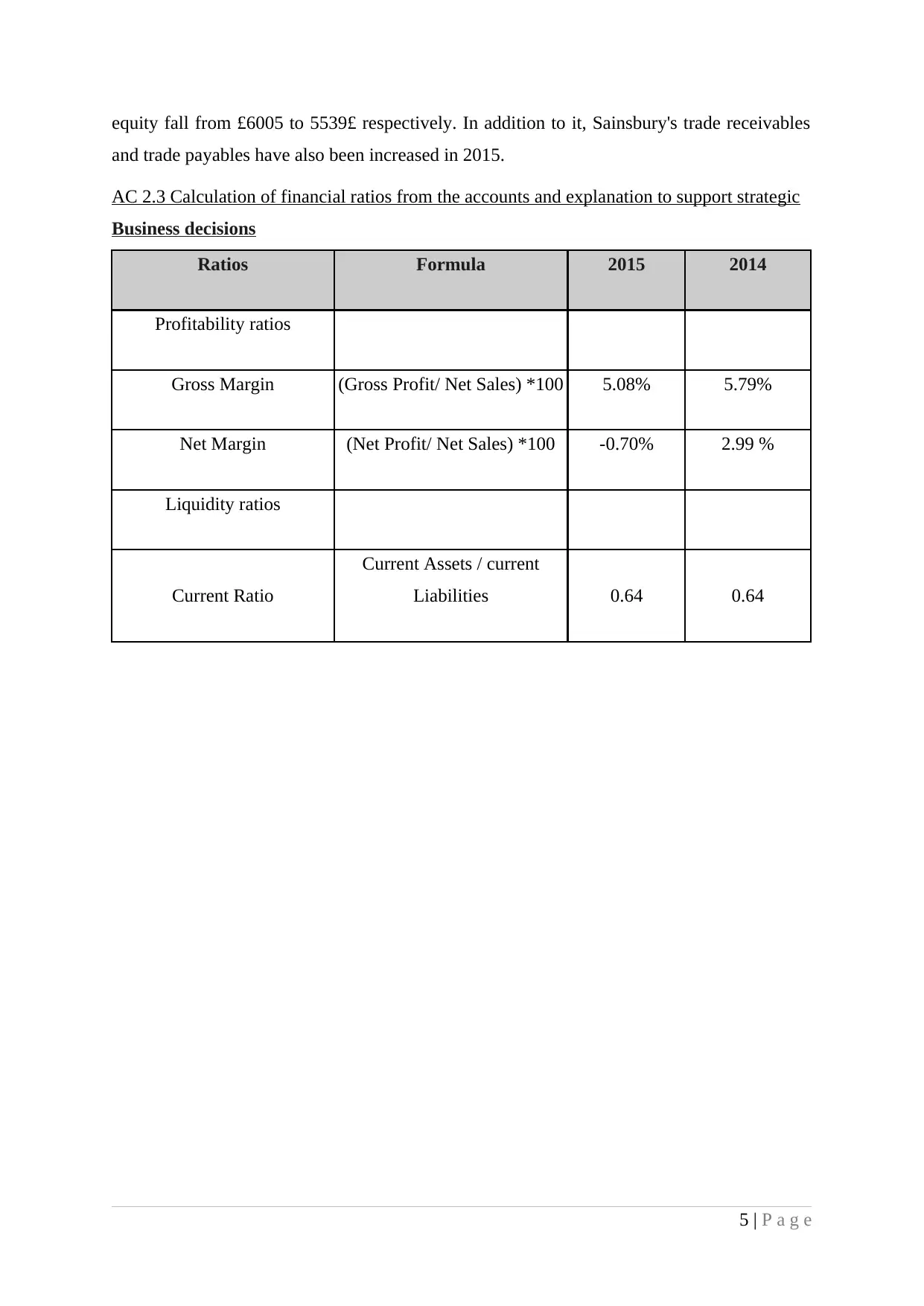
equity fall from £6005 to 5539£ respectively. In addition to it, Sainsbury's trade receivables
and trade payables have also been increased in 2015.
AC 2.3 Calculation of financial ratios from the accounts and explanation to support strategic
Business decisions
Ratios Formula 2015 2014
Profitability ratios
Gross Margin (Gross Profit/ Net Sales) *100 5.08% 5.79%
Net Margin (Net Profit/ Net Sales) *100 -0.70% 2.99 %
Liquidity ratios
Current Ratio
Current Assets / current
Liabilities 0.64 0.64
5 | P a g e
and trade payables have also been increased in 2015.
AC 2.3 Calculation of financial ratios from the accounts and explanation to support strategic
Business decisions
Ratios Formula 2015 2014
Profitability ratios
Gross Margin (Gross Profit/ Net Sales) *100 5.08% 5.79%
Net Margin (Net Profit/ Net Sales) *100 -0.70% 2.99 %
Liquidity ratios
Current Ratio
Current Assets / current
Liabilities 0.64 0.64
5 | P a g e
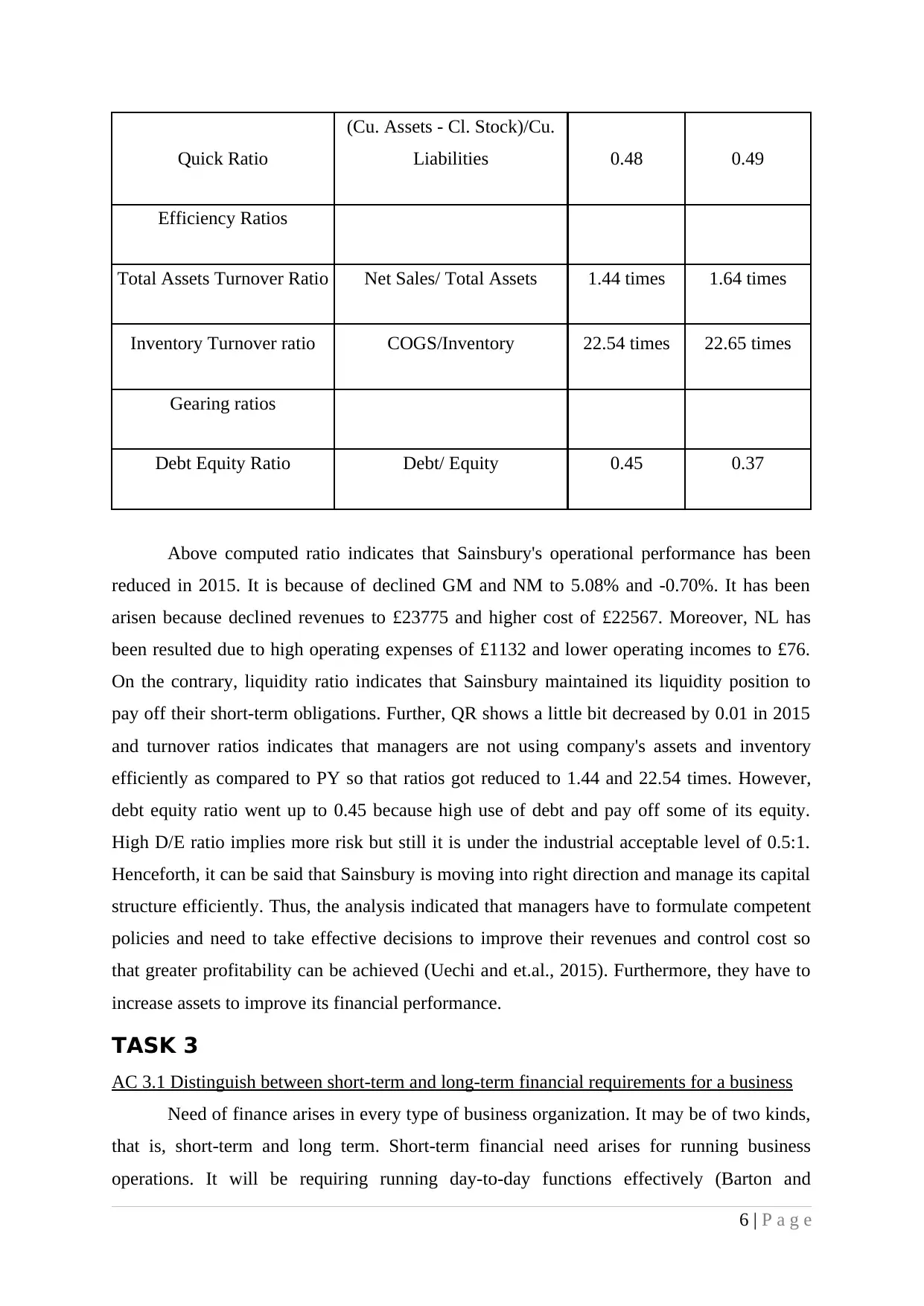
Quick Ratio
(Cu. Assets - Cl. Stock)/Cu.
Liabilities 0.48 0.49
Efficiency Ratios
Total Assets Turnover Ratio Net Sales/ Total Assets 1.44 times 1.64 times
Inventory Turnover ratio COGS/Inventory 22.54 times 22.65 times
Gearing ratios
Debt Equity Ratio Debt/ Equity 0.45 0.37
Above computed ratio indicates that Sainsbury's operational performance has been
reduced in 2015. It is because of declined GM and NM to 5.08% and -0.70%. It has been
arisen because declined revenues to £23775 and higher cost of £22567. Moreover, NL has
been resulted due to high operating expenses of £1132 and lower operating incomes to £76.
On the contrary, liquidity ratio indicates that Sainsbury maintained its liquidity position to
pay off their short-term obligations. Further, QR shows a little bit decreased by 0.01 in 2015
and turnover ratios indicates that managers are not using company's assets and inventory
efficiently as compared to PY so that ratios got reduced to 1.44 and 22.54 times. However,
debt equity ratio went up to 0.45 because high use of debt and pay off some of its equity.
High D/E ratio implies more risk but still it is under the industrial acceptable level of 0.5:1.
Henceforth, it can be said that Sainsbury is moving into right direction and manage its capital
structure efficiently. Thus, the analysis indicated that managers have to formulate competent
policies and need to take effective decisions to improve their revenues and control cost so
that greater profitability can be achieved (Uechi and et.al., 2015). Furthermore, they have to
increase assets to improve its financial performance.
TASK 3
AC 3.1 Distinguish between short-term and long-term financial requirements for a business
Need of finance arises in every type of business organization. It may be of two kinds,
that is, short-term and long term. Short-term financial need arises for running business
operations. It will be requiring running day-to-day functions effectively (Barton and
6 | P a g e
(Cu. Assets - Cl. Stock)/Cu.
Liabilities 0.48 0.49
Efficiency Ratios
Total Assets Turnover Ratio Net Sales/ Total Assets 1.44 times 1.64 times
Inventory Turnover ratio COGS/Inventory 22.54 times 22.65 times
Gearing ratios
Debt Equity Ratio Debt/ Equity 0.45 0.37
Above computed ratio indicates that Sainsbury's operational performance has been
reduced in 2015. It is because of declined GM and NM to 5.08% and -0.70%. It has been
arisen because declined revenues to £23775 and higher cost of £22567. Moreover, NL has
been resulted due to high operating expenses of £1132 and lower operating incomes to £76.
On the contrary, liquidity ratio indicates that Sainsbury maintained its liquidity position to
pay off their short-term obligations. Further, QR shows a little bit decreased by 0.01 in 2015
and turnover ratios indicates that managers are not using company's assets and inventory
efficiently as compared to PY so that ratios got reduced to 1.44 and 22.54 times. However,
debt equity ratio went up to 0.45 because high use of debt and pay off some of its equity.
High D/E ratio implies more risk but still it is under the industrial acceptable level of 0.5:1.
Henceforth, it can be said that Sainsbury is moving into right direction and manage its capital
structure efficiently. Thus, the analysis indicated that managers have to formulate competent
policies and need to take effective decisions to improve their revenues and control cost so
that greater profitability can be achieved (Uechi and et.al., 2015). Furthermore, they have to
increase assets to improve its financial performance.
TASK 3
AC 3.1 Distinguish between short-term and long-term financial requirements for a business
Need of finance arises in every type of business organization. It may be of two kinds,
that is, short-term and long term. Short-term financial need arises for running business
operations. It will be requiring running day-to-day functions effectively (Barton and
6 | P a g e
⊘ This is a preview!⊘
Do you want full access?
Subscribe today to unlock all pages.

Trusted by 1+ million students worldwide
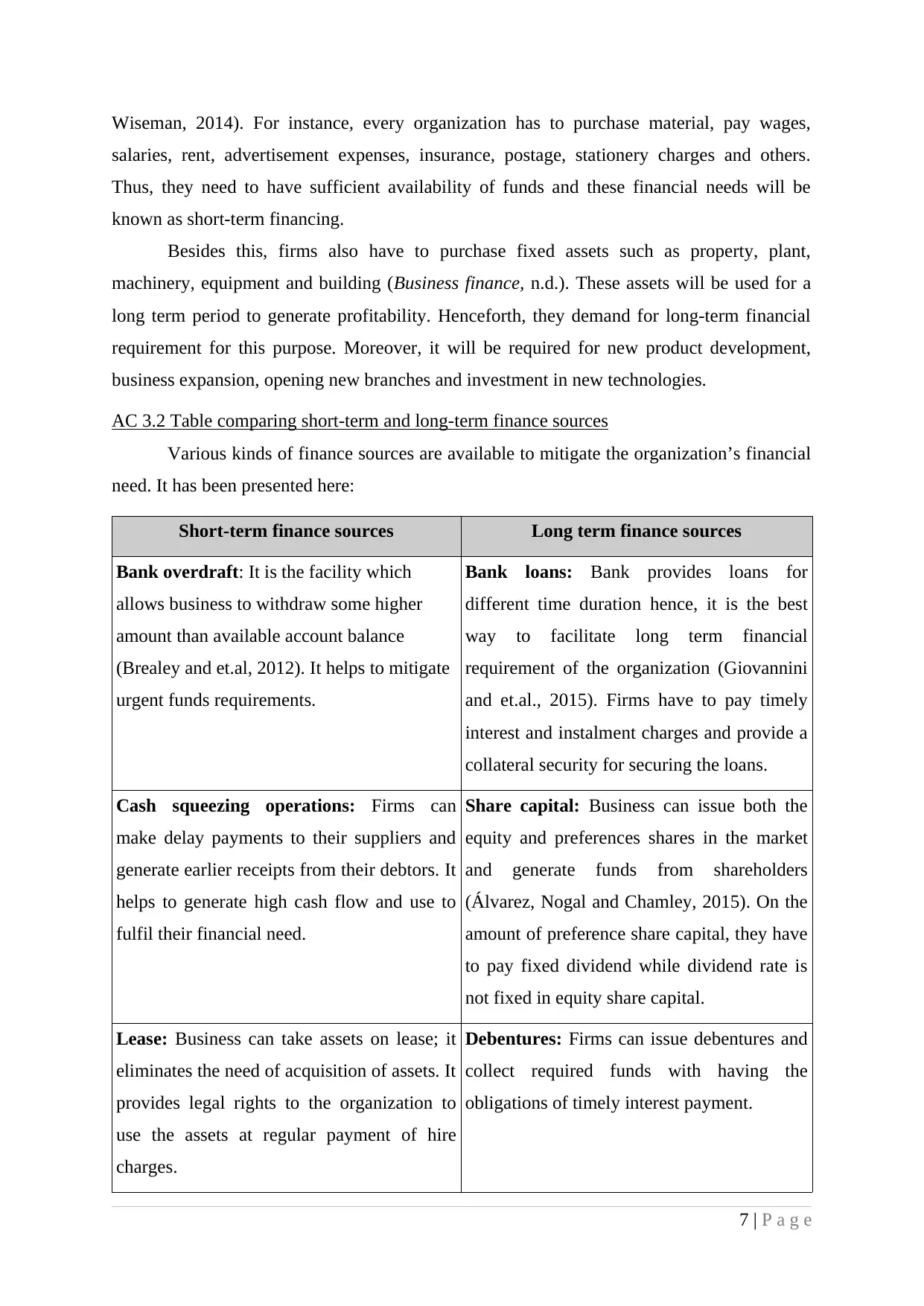
Wiseman, 2014). For instance, every organization has to purchase material, pay wages,
salaries, rent, advertisement expenses, insurance, postage, stationery charges and others.
Thus, they need to have sufficient availability of funds and these financial needs will be
known as short-term financing.
Besides this, firms also have to purchase fixed assets such as property, plant,
machinery, equipment and building (Business finance, n.d.). These assets will be used for a
long term period to generate profitability. Henceforth, they demand for long-term financial
requirement for this purpose. Moreover, it will be required for new product development,
business expansion, opening new branches and investment in new technologies.
AC 3.2 Table comparing short-term and long-term finance sources
Various kinds of finance sources are available to mitigate the organization’s financial
need. It has been presented here:
Short-term finance sources Long term finance sources
Bank overdraft: It is the facility which
allows business to withdraw some higher
amount than available account balance
(Brealey and et.al, 2012). It helps to mitigate
urgent funds requirements.
Bank loans: Bank provides loans for
different time duration hence, it is the best
way to facilitate long term financial
requirement of the organization (Giovannini
and et.al., 2015). Firms have to pay timely
interest and instalment charges and provide a
collateral security for securing the loans.
Cash squeezing operations: Firms can
make delay payments to their suppliers and
generate earlier receipts from their debtors. It
helps to generate high cash flow and use to
fulfil their financial need.
Share capital: Business can issue both the
equity and preferences shares in the market
and generate funds from shareholders
(Álvarez, Nogal and Chamley, 2015). On the
amount of preference share capital, they have
to pay fixed dividend while dividend rate is
not fixed in equity share capital.
Lease: Business can take assets on lease; it
eliminates the need of acquisition of assets. It
provides legal rights to the organization to
use the assets at regular payment of hire
charges.
Debentures: Firms can issue debentures and
collect required funds with having the
obligations of timely interest payment.
7 | P a g e
salaries, rent, advertisement expenses, insurance, postage, stationery charges and others.
Thus, they need to have sufficient availability of funds and these financial needs will be
known as short-term financing.
Besides this, firms also have to purchase fixed assets such as property, plant,
machinery, equipment and building (Business finance, n.d.). These assets will be used for a
long term period to generate profitability. Henceforth, they demand for long-term financial
requirement for this purpose. Moreover, it will be required for new product development,
business expansion, opening new branches and investment in new technologies.
AC 3.2 Table comparing short-term and long-term finance sources
Various kinds of finance sources are available to mitigate the organization’s financial
need. It has been presented here:
Short-term finance sources Long term finance sources
Bank overdraft: It is the facility which
allows business to withdraw some higher
amount than available account balance
(Brealey and et.al, 2012). It helps to mitigate
urgent funds requirements.
Bank loans: Bank provides loans for
different time duration hence, it is the best
way to facilitate long term financial
requirement of the organization (Giovannini
and et.al., 2015). Firms have to pay timely
interest and instalment charges and provide a
collateral security for securing the loans.
Cash squeezing operations: Firms can
make delay payments to their suppliers and
generate earlier receipts from their debtors. It
helps to generate high cash flow and use to
fulfil their financial need.
Share capital: Business can issue both the
equity and preferences shares in the market
and generate funds from shareholders
(Álvarez, Nogal and Chamley, 2015). On the
amount of preference share capital, they have
to pay fixed dividend while dividend rate is
not fixed in equity share capital.
Lease: Business can take assets on lease; it
eliminates the need of acquisition of assets. It
provides legal rights to the organization to
use the assets at regular payment of hire
charges.
Debentures: Firms can issue debentures and
collect required funds with having the
obligations of timely interest payment.
7 | P a g e
Paraphrase This Document
Need a fresh take? Get an instant paraphrase of this document with our AI Paraphraser
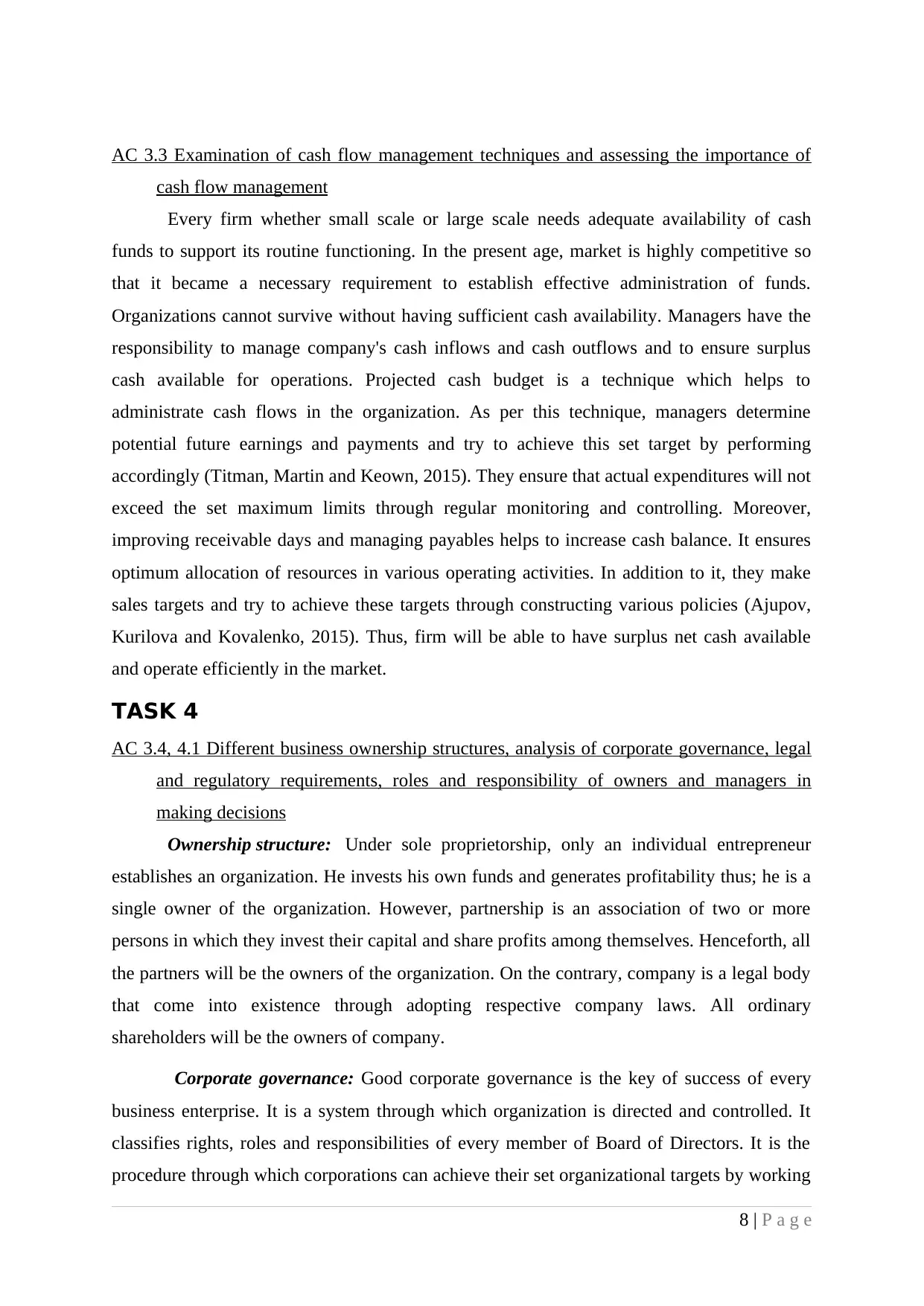
AC 3.3 Examination of cash flow management techniques and assessing the importance of
cash flow management
Every firm whether small scale or large scale needs adequate availability of cash
funds to support its routine functioning. In the present age, market is highly competitive so
that it became a necessary requirement to establish effective administration of funds.
Organizations cannot survive without having sufficient cash availability. Managers have the
responsibility to manage company's cash inflows and cash outflows and to ensure surplus
cash available for operations. Projected cash budget is a technique which helps to
administrate cash flows in the organization. As per this technique, managers determine
potential future earnings and payments and try to achieve this set target by performing
accordingly (Titman, Martin and Keown, 2015). They ensure that actual expenditures will not
exceed the set maximum limits through regular monitoring and controlling. Moreover,
improving receivable days and managing payables helps to increase cash balance. It ensures
optimum allocation of resources in various operating activities. In addition to it, they make
sales targets and try to achieve these targets through constructing various policies (Ajupov,
Kurilova and Kovalenko, 2015). Thus, firm will be able to have surplus net cash available
and operate efficiently in the market.
TASK 4
AC 3.4, 4.1 Different business ownership structures, analysis of corporate governance, legal
and regulatory requirements, roles and responsibility of owners and managers in
making decisions
Ownership structure: Under sole proprietorship, only an individual entrepreneur
establishes an organization. He invests his own funds and generates profitability thus; he is a
single owner of the organization. However, partnership is an association of two or more
persons in which they invest their capital and share profits among themselves. Henceforth, all
the partners will be the owners of the organization. On the contrary, company is a legal body
that come into existence through adopting respective company laws. All ordinary
shareholders will be the owners of company.
Corporate governance: Good corporate governance is the key of success of every
business enterprise. It is a system through which organization is directed and controlled. It
classifies rights, roles and responsibilities of every member of Board of Directors. It is the
procedure through which corporations can achieve their set organizational targets by working
8 | P a g e
cash flow management
Every firm whether small scale or large scale needs adequate availability of cash
funds to support its routine functioning. In the present age, market is highly competitive so
that it became a necessary requirement to establish effective administration of funds.
Organizations cannot survive without having sufficient cash availability. Managers have the
responsibility to manage company's cash inflows and cash outflows and to ensure surplus
cash available for operations. Projected cash budget is a technique which helps to
administrate cash flows in the organization. As per this technique, managers determine
potential future earnings and payments and try to achieve this set target by performing
accordingly (Titman, Martin and Keown, 2015). They ensure that actual expenditures will not
exceed the set maximum limits through regular monitoring and controlling. Moreover,
improving receivable days and managing payables helps to increase cash balance. It ensures
optimum allocation of resources in various operating activities. In addition to it, they make
sales targets and try to achieve these targets through constructing various policies (Ajupov,
Kurilova and Kovalenko, 2015). Thus, firm will be able to have surplus net cash available
and operate efficiently in the market.
TASK 4
AC 3.4, 4.1 Different business ownership structures, analysis of corporate governance, legal
and regulatory requirements, roles and responsibility of owners and managers in
making decisions
Ownership structure: Under sole proprietorship, only an individual entrepreneur
establishes an organization. He invests his own funds and generates profitability thus; he is a
single owner of the organization. However, partnership is an association of two or more
persons in which they invest their capital and share profits among themselves. Henceforth, all
the partners will be the owners of the organization. On the contrary, company is a legal body
that come into existence through adopting respective company laws. All ordinary
shareholders will be the owners of company.
Corporate governance: Good corporate governance is the key of success of every
business enterprise. It is a system through which organization is directed and controlled. It
classifies rights, roles and responsibilities of every member of Board of Directors. It is the
procedure through which corporations can achieve their set organizational targets by working
8 | P a g e
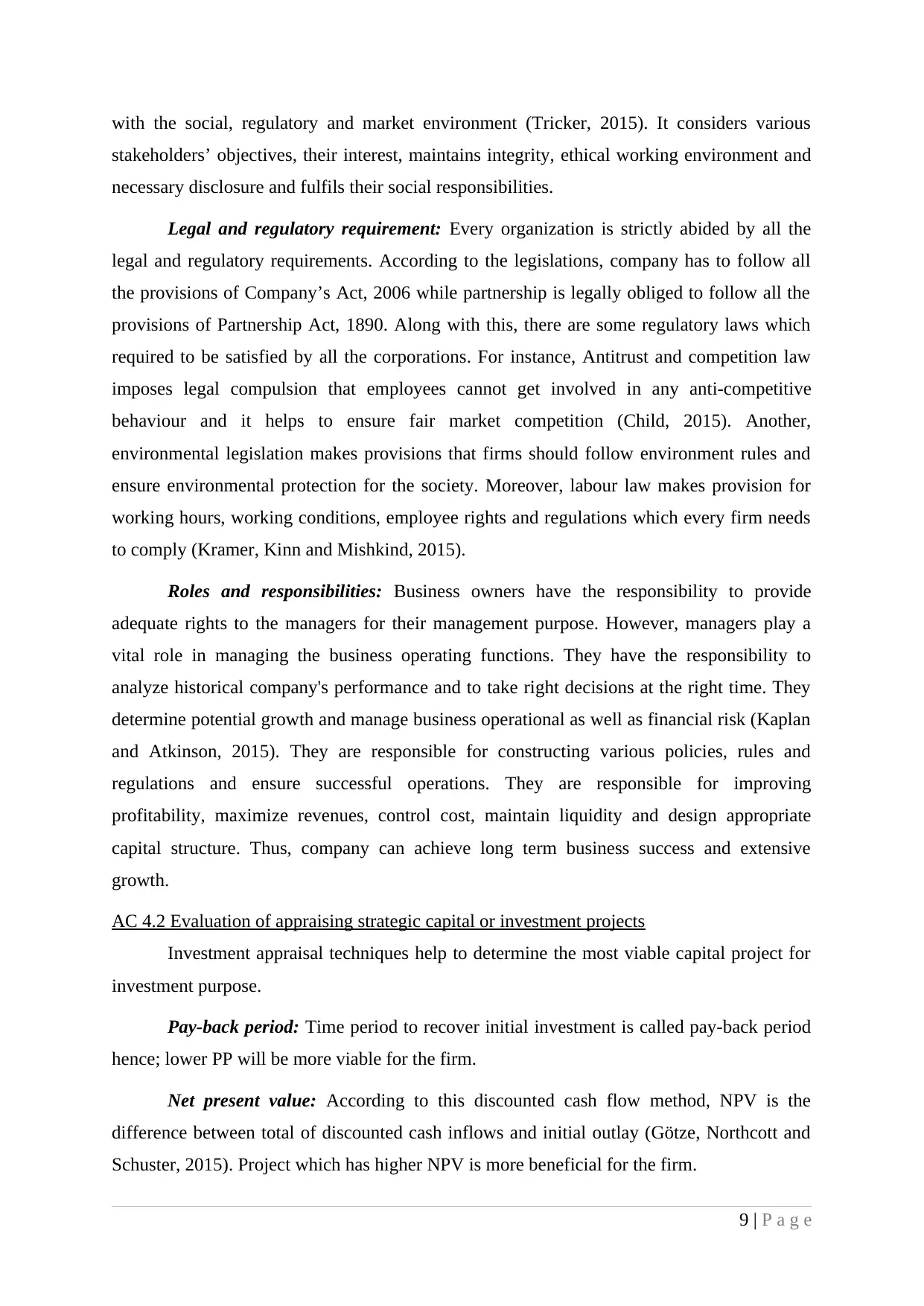
with the social, regulatory and market environment (Tricker, 2015). It considers various
stakeholders’ objectives, their interest, maintains integrity, ethical working environment and
necessary disclosure and fulfils their social responsibilities.
Legal and regulatory requirement: Every organization is strictly abided by all the
legal and regulatory requirements. According to the legislations, company has to follow all
the provisions of Company’s Act, 2006 while partnership is legally obliged to follow all the
provisions of Partnership Act, 1890. Along with this, there are some regulatory laws which
required to be satisfied by all the corporations. For instance, Antitrust and competition law
imposes legal compulsion that employees cannot get involved in any anti-competitive
behaviour and it helps to ensure fair market competition (Child, 2015). Another,
environmental legislation makes provisions that firms should follow environment rules and
ensure environmental protection for the society. Moreover, labour law makes provision for
working hours, working conditions, employee rights and regulations which every firm needs
to comply (Kramer, Kinn and Mishkind, 2015).
Roles and responsibilities: Business owners have the responsibility to provide
adequate rights to the managers for their management purpose. However, managers play a
vital role in managing the business operating functions. They have the responsibility to
analyze historical company's performance and to take right decisions at the right time. They
determine potential growth and manage business operational as well as financial risk (Kaplan
and Atkinson, 2015). They are responsible for constructing various policies, rules and
regulations and ensure successful operations. They are responsible for improving
profitability, maximize revenues, control cost, maintain liquidity and design appropriate
capital structure. Thus, company can achieve long term business success and extensive
growth.
AC 4.2 Evaluation of appraising strategic capital or investment projects
Investment appraisal techniques help to determine the most viable capital project for
investment purpose.
Pay-back period: Time period to recover initial investment is called pay-back period
hence; lower PP will be more viable for the firm.
Net present value: According to this discounted cash flow method, NPV is the
difference between total of discounted cash inflows and initial outlay (Götze, Northcott and
Schuster, 2015). Project which has higher NPV is more beneficial for the firm.
9 | P a g e
stakeholders’ objectives, their interest, maintains integrity, ethical working environment and
necessary disclosure and fulfils their social responsibilities.
Legal and regulatory requirement: Every organization is strictly abided by all the
legal and regulatory requirements. According to the legislations, company has to follow all
the provisions of Company’s Act, 2006 while partnership is legally obliged to follow all the
provisions of Partnership Act, 1890. Along with this, there are some regulatory laws which
required to be satisfied by all the corporations. For instance, Antitrust and competition law
imposes legal compulsion that employees cannot get involved in any anti-competitive
behaviour and it helps to ensure fair market competition (Child, 2015). Another,
environmental legislation makes provisions that firms should follow environment rules and
ensure environmental protection for the society. Moreover, labour law makes provision for
working hours, working conditions, employee rights and regulations which every firm needs
to comply (Kramer, Kinn and Mishkind, 2015).
Roles and responsibilities: Business owners have the responsibility to provide
adequate rights to the managers for their management purpose. However, managers play a
vital role in managing the business operating functions. They have the responsibility to
analyze historical company's performance and to take right decisions at the right time. They
determine potential growth and manage business operational as well as financial risk (Kaplan
and Atkinson, 2015). They are responsible for constructing various policies, rules and
regulations and ensure successful operations. They are responsible for improving
profitability, maximize revenues, control cost, maintain liquidity and design appropriate
capital structure. Thus, company can achieve long term business success and extensive
growth.
AC 4.2 Evaluation of appraising strategic capital or investment projects
Investment appraisal techniques help to determine the most viable capital project for
investment purpose.
Pay-back period: Time period to recover initial investment is called pay-back period
hence; lower PP will be more viable for the firm.
Net present value: According to this discounted cash flow method, NPV is the
difference between total of discounted cash inflows and initial outlay (Götze, Northcott and
Schuster, 2015). Project which has higher NPV is more beneficial for the firm.
9 | P a g e
⊘ This is a preview!⊘
Do you want full access?
Subscribe today to unlock all pages.

Trusted by 1+ million students worldwide
1 out of 16
Related Documents
Your All-in-One AI-Powered Toolkit for Academic Success.
+13062052269
info@desklib.com
Available 24*7 on WhatsApp / Email
![[object Object]](/_next/static/media/star-bottom.7253800d.svg)
Unlock your academic potential
Copyright © 2020–2025 A2Z Services. All Rights Reserved. Developed and managed by ZUCOL.





